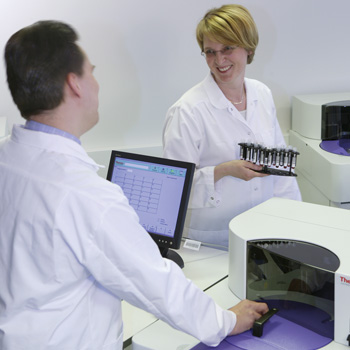Optimum Control of Acrylamide

Asparagine is one of the most common natural amino acids. A reaction between asparagine and reducing sugars or reactive carbonyls produces acrylamide, a suspected carcinogen which forms in certain foods when they are heated to sufficient temperatures. Formation of acrylamide is a concern in the processing of fried and roasted processed foods, such as potato chips or fries, baked cereals and roasted coffee beans. The potential for acrylamide formation directly correlates with the content of asparagine and reducing sugars in the food, and the formation process can be controlled if the levels of the precursors are known.
For such detection, a quick and reliable enzymatic method has been developed for acrylamide control in raw and processed foods, employing the automated Thermo Scientific Arena analyzer, which utilizes discrete cell technology to enable the simultaneous analysis of several different parameters from the same sample. Separate analytical methods, like the determination of asparagine and sugars, glucose and fructose, can be run simultaneously from a single sample, significantly reducing analysis time. Its automated features ensure walk-away analysis delivering improved efficiency and time and cost savings by providing the operator flexibility to work on other tasks. The special micro-volume cuvette design enables small reagent volumes making the system economical to use. Enzyme reaction with its substrate is highly specific, so measurements can be done in low levels with high reproducibility.
Applications of this analyzer are based on photometric measurements and the wavelength range covers filter configurations from 340 nm to 880 nm. The method developed for the analysis of asparagine is a three-reagent reduction reaction, consisting of a nicotinamide adenine dinucleotide phosphate (NADPH) in 2-oxoglutarate buffer, glutamate dehydrogenase, and asparaginase. Measurement is done at 340 nm.
The analyzer handles all the steps of the analysis and each individual reaction is isolated and temperature-stabilized. The reaction takes place in micro-volume cuvettes that are automatically deposited to a waste bin after use. Sample pretreatment is minimal; generally centrifugation or filtration is adequate to prepare the samples. With potatoes, for example, juice is extracted by a separator and Carrez clarification is performed to stabilize the juice and to stop microbiological activity. The samples are then ready for analysis. The sample matrix effects can be eliminated by using the instrument’s several blanking possibilities. Automatic dilutions help to manage different concentration levels with no additional effort.
During the reaction, the incubator of the analyzer maintains the specified temperature of 37 °C, ensuring a high level of control in the enzymatic reaction. The reaction temperature is freely adjustable up to 50 °C. Since the cuvettes are disposable, there is no need for extra cleanouts or rinsing of the system to avoid carryover or contamination. Microliter-volume samples reduce waste and operating costs. Compared with manual methods, the analyzer uses 10–15 times less reagent, which is especially important when working with valuable reagents.
Thermo Scientific Arena reagent kits are available for D-glucose and D-fructose as well as sucrose, ammonia, glycerol, ethanol, acetic acid, lactic acid and malic acid determinations. All of the kit components are ready-to-use liquids, eliminating the need for reagent preparation. An analyzer can have 35 or 45 reagents simultaneously on-board and application parameters allow up to four reagent additions in each test.
A wide selection of system applications are available not only for asparagine and reducing sugars but also for different acids. For example, fermentation processes are easily controlled with the analyzer. Its open concept allows customers to set up their own applications with method parameters freely designed by the user.
Since the analyzer requires minimal daily and weekly maintenance, it maximizes uptime. There is no need for external water or drainage connections and the system’s small footprint facilitates installation in any laboratory. Available in four different models, it fulfills different capacity needs in different size laboratories. All four analyzers have the same graphical user interface which is intuitive and simple to use. Analyzers can be connected to the laboratory information system (LIMS) for automatic request querying and/or automatic result reporting.
These analyzers are easy-to-use automated systems for product analysis and quality control, offering flexibility, speed, accuracy and precision measurements. Samples, reagents and consumables can be loaded at any time without interrupting the analysis. Once loaded, the analyzer can run without the assistance of the analyst.
www.thermo.com/arena
Looking for a reprint of this article?
From high-res PDFs to custom plaques, order your copy today!





